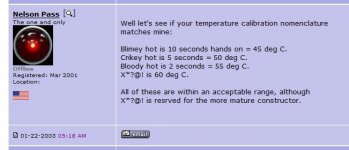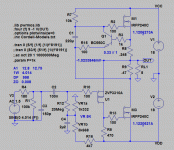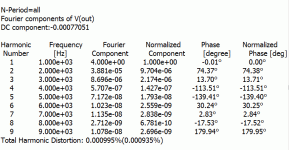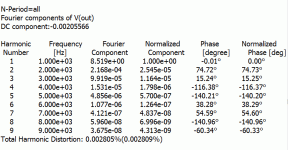Bias point still fluctuates before heatsink temperature stabilize.
indra1,
I listen to music in my barn workshop. Often very cold or very hot, with very few Goldilocks days. On a cold day it takes around an hour for everything to warm up. That is:- batteries, electronics, and speaker coil, and then we are cooking. Surprising how much the dynamic range and the ability to handle complex passages of music really opens up. When it hits 100F on a hot day, I call it quits.
Just my observations, as such.
ToS
Bias point still fluctuates before heatsink temperature stabilize.
so is it a matter of design?
because that h/k found it's happy place 'Hot' where
most would dare not go.
I mean I never measured it but the first few times it did it I was concerned......after awhile it was second nature.
and like I said it took that type of abuse for over 15 yrs!
during the autopsy I could tell by the caramel toned internals and slightly melted bits of plastic that it's life was spent on the edge.
the R-N803 likes it warm but gets nowhere near the H/K.....
The Hint in its current state of tune doesn't like to be pushed at all.....it plateaus at around 100db @l.p.
all things the same the R-N803 does 105 @l.p. and could probably go more but I think that's my speakers limitation.
I’m thinking I need to get on the class A train
Mind you, (simple) class A amps are not natural sounding amps.
Before you go to class A, may be you want to try Gainclone first. I think it is a critical milestone in amplifiers DIY. It is simple, cheap, but can sound better than seriously built commercial or DIY (I think Jeff Rowland used the chip amps in his expensive amp). The simple one is controversial, so you might want to try the composite version (Mauro Penasa's My_Ref). The original was using too gross power supply for the LM318 opamp, which was improved by Fremen with much better power supply. I'm sure you will like this amp better than your previous commercial amps.
Perhaps in your own opinion. Others say the opposite, in their opinion.Mind you, (simple) class A amps are not natural sounding amps.
Every transistor, just like every tube, has its own "signature" that it adds to the signal chain.
However tiny or minute it would be, it's there, regardless.
and the passive components (resistors/capacitors/etc) used to connect and make operable these transistors also command how said transistors will ultimately function.
With that said, consider an amplifier with 20 to 40 transistors from input to speaker.
While it may sound nice enough, that audio signal has negotiated through all those transistors, and components.
This of course can result in "noise" generated into the original signal in various forms.
Phase relationships, hiss, etc., all combine to "distort" the final signal that the speaker gets.
The electrons get a nice excersize "workout" getting to that speaker, don't they?
A simple thing like an op amp IC loaded with "junctions" introduces its own blend of "distortions" as well.
As for me, I like to keep things simple, in the interest of "purity".
I want that phono cartridge's signal to pass through as FEW silicon junctions as possible.
The less it's "touched" the better.
The one amp I built recently only has 11 measily transistors from phono cartridge signal to speaker, (per channel) and it sounds great.
Purity, it's a great thing.
However tiny or minute it would be, it's there, regardless.
and the passive components (resistors/capacitors/etc) used to connect and make operable these transistors also command how said transistors will ultimately function.
With that said, consider an amplifier with 20 to 40 transistors from input to speaker.
While it may sound nice enough, that audio signal has negotiated through all those transistors, and components.
This of course can result in "noise" generated into the original signal in various forms.
Phase relationships, hiss, etc., all combine to "distort" the final signal that the speaker gets.
The electrons get a nice excersize "workout" getting to that speaker, don't they?
A simple thing like an op amp IC loaded with "junctions" introduces its own blend of "distortions" as well.
As for me, I like to keep things simple, in the interest of "purity".
I want that phono cartridge's signal to pass through as FEW silicon junctions as possible.
The less it's "touched" the better.
The one amp I built recently only has 11 measily transistors from phono cartridge signal to speaker, (per channel) and it sounds great.
Purity, it's a great thing.
My_Ref Fremen Edition - Build thread and tutorial. The schema is in the google drive link of the first post. May be you can find the PCB somewhere on ebay or something.thanks, are there any links to it?
Exactly! That's why I didn't comment when Bob said that his amps are not unnatural. Well, we know the Yamaha motto, right? Simple class A amps just have too much low order distortions. For some this is what makes the amp to sound more natural.Perhaps in your own opinion. Others say the opposite, in their opinion.
Purity is a great thing when there are too many things going wrong in a complex circuit. It's not the number of the transistors itself, it is how they are misused.As for me, I like to keep things simple, in the interest of "purity". I want that phono cartridge's signal to pass through as FEW silicon junctions as possible. The less it's "touched" the better.
The one amp I built recently only has 11 measily transistors from phono cartridge signal to speaker, (per channel) and it sounds great.
Purity, it's a great thing.
Let's see an opamp example. One opamp consists of a lot of transistors and gain stages. Will extra opamps (as input buffer and output buffer) will tripple the amount of misuses? Most likely not. Most opamp circuits will perform better when they drive higher load (above 10k) and driven by low impedance source. And the buffers are usually much happier because the gain is very low.
Simplicity is good as long as each of the transistors work in their 'comfort zones'. To make sure that each transistor works in 'comfort zone' we add more transistors (increase complexity).
Simple class A amps just have too much low order distortions. For some this is what makes the amp to sound more natural.
This can not be considered as common statement, one could do class A with deep GNFB, with record minimum THD. Class A does not add transistors switching noise into NFB loop, this is important. On the other hand, many people look for natural sound by minimizing amount of transistors in class A (even SE) schematics. This usually leads to more "slow" sound (but very pure and with best vocal reproduction). And, one choose what is preferable.
That's why I thought it was not common that Bob or any audiophile complains that the sound is 'slow'. Usually this 'slowness' is what they want.This usually leads to more "slow" sound (but very pure and with best vocal reproduction).
Bob also mentioned slew rate, but I think JC likes high slew rate in his amps, so it is not because of the lack of it. High slew rate tends to increase the overshoot factor. But from Stereophile measurement I could see that the Parasound has so smooth squarewave. May be JC tried to make this smooth (for marketing purpose) and the effect is something that Bob didn't like. From Bob description of the sound, I thought there is possibility that base resistors have been aggressively used. But if we follow the logic that all amps sound the same, it could be just Bob's ears
Many trained listeners perceive distortion as distortion or an unnatural thing whether it is high order or low order.many people look for natural sound by minimizing amount of transistors in class A (even SE) schematics. This usually leads to more "slow" sound (but very pure and with best vocal reproduction).
It is difficult to say anything of an amp when measured performance is not available. What do you guys think of this 10W Class A follower, 9.95 ppm @ 1W? I would not be surprised if it turns out to sound grainy on top regardless.
Attachments
How is this at 4.5W? (ACA#1 is 1%)It is difficult to say anything of an amp when measured performance is not available. What do you guys think of this 10W Class A follower, 9.95 ppm @ 1W? I would not be surprised if it turns out to sound grainy on top regardless.
Many trained listeners perceive distortion as distortion or an unnatural thing whether it is high order or low order.
That can be not a distortion measured with resistive load. Effect of "slow amp" could be due to interaction with speaker as a complicated load.
Just to explain the point. I have tested various hybrid amps, input is the same tube schematics, outputs are along the lines of Ciuffolli follower. SE topology, no GNFB. Output buffers are based on
1) MOSFETS
2) VHF BJT rated at 300W dissipation resulted amp 5A standing current 50W
3) Ge BJT resulted amp 2,5A 10W
The fastest and purest sound was with Ge output amp. It has lowerst output resistance (0,018 Ohms without NFB !), because some specifity of Ge transistors. Si BJT amp has around 0,14 Ohms output resistance. 2nd harmonic measured with resistive load says almost nothing.
0,018 Ohms without NFB
News to me. Thank you!
- Status
- This old topic is closed. If you want to reopen this topic, contact a moderator using the "Report Post" button.
- Home
- Member Areas
- The Lounge
- What causes grainy sound



